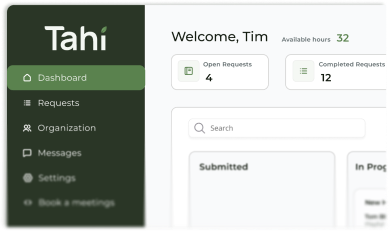Web Design
A 5-Step Content Audit for Your Website Redesign
Planning a website redesign? Don't risk your SEO. Our 5-step mini content audit guide helps you keep what works, fix what's broken, and launch strong.

Why a Content Audit is Non-Negotiable
Here’s a scenario we see all the time. A business invests thousands of dollars and countless hours into a stunning new website design. It launches, and everyone celebrates. Then, a month later, the marketing team notices a horrifying trend: organic traffic has fallen off a cliff. Panic sets in. What went wrong?
Nine times out of ten, the culprit is a lack of a content audit. The team was so focused on the look and feel that they simply ‘lifted and shifted’ all their old content into the new design, or worse, deleted pages without a second thought. Think of it like moving house. You wouldn't just shovel all the junk from your old garage into your new one; you'd have a proper clear-out first. A content audit is that clear-out for your website.
It's not just about avoiding disaster; it's about actively improving performance. The data doesn't lie. One company, HomeScienceTools.com, saw a 64% increase in organic revenue after a redesign that included pruning underperforming content. By removing the dead weight, they allowed Google to focus on their best pages, boosting their overall authority. A content audit isn't just a preliminary step; it's the strategic foundation for a successful redesign.
The 5-Step Mini-Audit Framework
Alright, let's get practical. A full-scale content audit can be a massive undertaking, but a focused ‘mini-audit’ is manageable and delivers huge value before a redesign. Here's our five-step process to get it done without losing your mind.
Step 1: Define Your Redesign Goals
Before you look at a single page, you need to know what you're trying to achieve. If you don't know the destination, you can't draw the map. Are you trying to increase lead generation? Reduce bounce rates? Improve your site’s Information Architecture (IA) to help users find information faster? Before you ask if your website is truly working, you need to define what 'working' actually means for your business.
Get your stakeholders in a room (or a video call) and agree on a handful of key performance indicators (KPIs). This clarity will be your North Star, guiding every decision you make about which content supports your goals and which is just taking up space.
Step 2: Create Your Content Inventory
Now it's time to create your master list. You need a complete inventory of every page on your website. Don't panic; you don't have to do this manually. Tools like Screaming Frog or the site audit feature in Ahrefs can crawl your site and export a list of all your URLs in minutes.
Create a spreadsheet with the following columns:
- URL: The full address of the page.
- Page Title: The H1 or title tag of the page.
- Content Type: (e.g., Blog Post, Service Page, Landing Page).
- Organic Traffic (Last 90 days): Pull this from Google Analytics or Google Search Console.
- Bounce Rate: How many people leave after viewing only one page?
- Conversions/Goals: How many people completed a desired action?
- Backlinks: How many other sites link to this page? (You can get this from Ahrefs or Moz).
This spreadsheet is now your single source of truth for the entire audit process.
Step 3: Analyse the Data (Keep, Improve, Consolidate, or Delete)
This is where the real work begins. Looking at your spreadsheet, you're going to make a decision for every single URL. We use a simple four-category framework to keep things clear.
- Keep: These are your superstars. High traffic, high engagement, good conversions. These pages are clearly working. Your job is to protect them. Ensure they are migrated to the new design with their URL and content intact. Don't try to fix what isn't broken.
- Improve: This is content with potential. Maybe it ranks on the second page of Google for a valuable keyword, or it covers a great topic but the information is outdated. This content needs a refresh. Plan to update it with new information, improve the on-page SEO, add new visuals, or expand it to be more comprehensive.
- Consolidate: Do you have three or four blog posts all covering slight variations of the same topic? This is a huge opportunity. Consolidating these weaker pages into one comprehensive, powerhouse article is a brilliant SEO strategy. You combine their authority into a single resource. Just make sure you properly 301 redirect the old URLs to the new one to pass on all that link equity.
- Delete: This is the dead weight. Pages with zero traffic, no backlinks, and no strategic value. Think old press releases, expired event pages, or thin blog posts that never gained traction. Be ruthless. Deleting these pages (and letting them 404 or redirecting to a relevant parent category) helps Google focus on your quality content, a practice known as content pruning. Data doesn't care about your feelings, and neither does Google.
Step 4: Check for Technical SEO Gremlins
With your content plan taking shape, it's time for a quick technical check. A redesign is the perfect opportunity to clean up any lingering issues and avoid creating new ones. A major risk during any site change is accumulating Technical Debt by making quick fixes that cause bigger problems later.
Focus on these key areas:
- Internal Links: As you consolidate and delete pages, you need to update any internal links pointing to them. A broken internal link is a dead end for users and search engine crawlers.
- Redirect Plan: This is critical. Any URL that is changing needs a 301 redirect. This tells search engines that the page has moved permanently, and it passes most of the old page's authority to the new one. Forgetting this is the number one cause of traffic loss after a redesign.
- Duplicate Content: Run a check for duplicate or very similar content across your site. This can confuse search engines and dilute your rankings. The consolidation plan from Step 3 should solve most of this.
The technical side of a migration can be complex. If you're feeling out of your depth, this is a great time to get an expert opinion. A Free Site Audit can often uncover these hidden issues before they become post-launch headaches.
Step 5: Build Your Action Plan
You've done the analysis; now it's time to create a clear, actionable plan. Go back to your master spreadsheet and add a few final columns:
- Action: (Keep, Improve, Consolidate, Delete).
- New URL (if applicable): Where will the consolidated page live?
- Notes: What specific improvements are needed? Who is responsible?
- Redirect Required?: (Yes/No).
This document becomes the blueprint for your content migration. It ensures nothing gets forgotten and that your development team knows exactly what to do with every single piece of content. Following a clear plan is the difference between a smooth transition and a chaotic launch. If you need a more detailed guide, check out our checklist for a smooth Webflow migration.
Conclusion: Build on Bedrock, Not Sand
A website redesign is a fantastic opportunity to level up your digital presence. But a beautiful design is only as good as the foundation it's built on. By taking the time to conduct a mini content audit, you're not adding unnecessary work; you're ensuring your investment pays off. You're clearing out the clutter, focusing on what truly works for your audience, and protecting your most valuable marketing asset: your organic search presence.
You'll launch your new site with confidence, knowing that every page has a purpose and that you're set up for growth from day one. It's about working smarter, not harder, and building your new digital home on bedrock, not sand.
Ready to start your redesign on the right foot? Let's begin with a thorough, no-obligation Free Site Audit to see where you stand.







